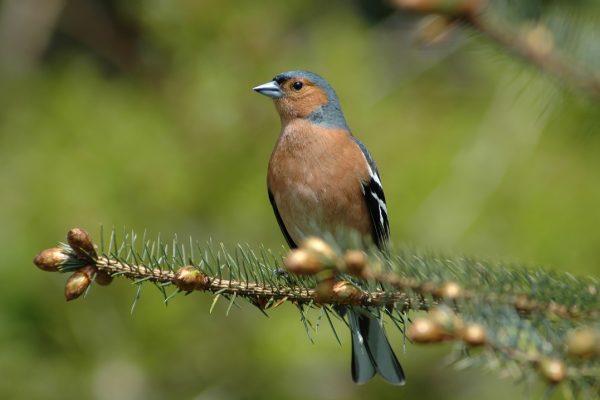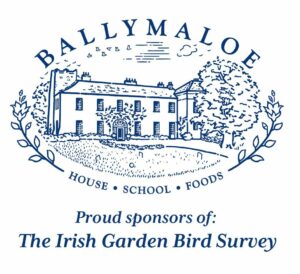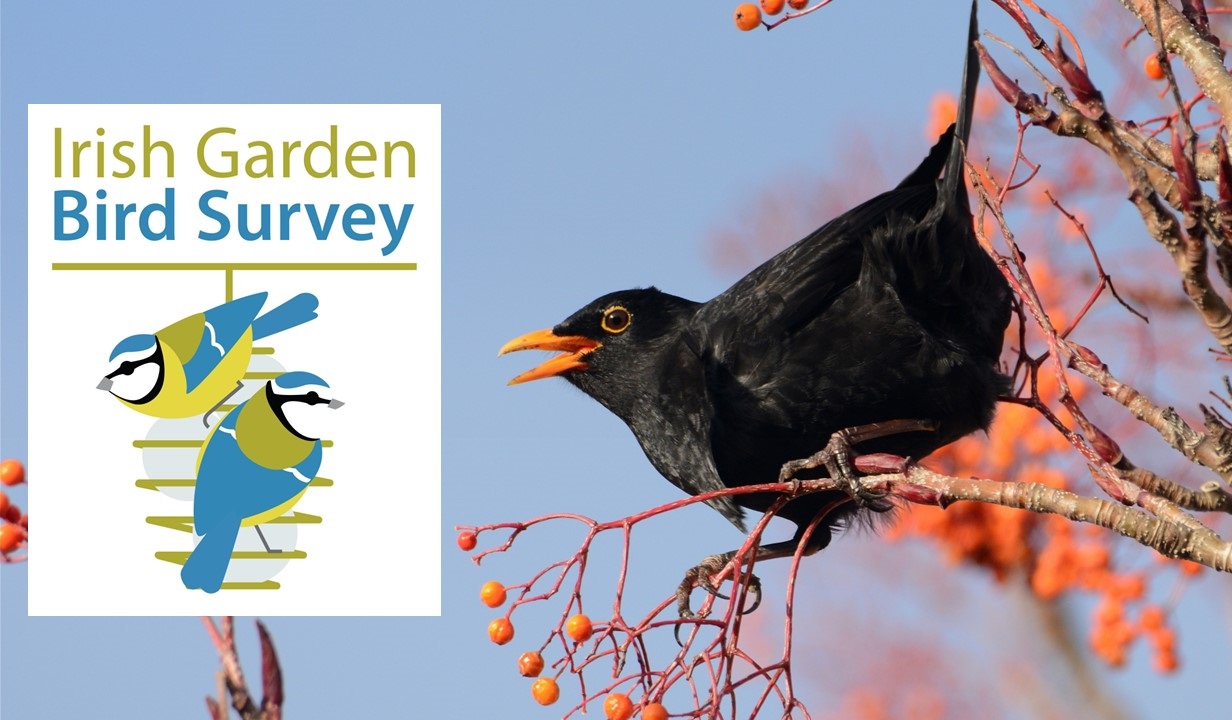
Chaffinch
| Irish Name: | Rí Rua |
| Scientific name: | Fringilla coelebs |
| Bird Family: | Finches |
green
Conservation status
Conservation status
Status
Resident, augmented by winter visitors from Britain and northern Europe. One of Ireland's top 20 most widespread garden birds.
Identification
Our commonest finch - found in woodland, farmland, parks and gardens. In winter can form large flocks of hundreds of birds, especially in stubble fields and under beech trees. The male's breast, face and underside are a pinkish orange-brown, becoming a darker, wine shade in winter. The nape and crown are blue-grey. The upper back is warm brown, while the lower back/rump is a contrasting green tone, usually hidden by the bird's folded wings when perched. The female is much greyer, with washed out warm grey underparts. Both sexes display large white patches on otherwise blackish wings, both when perched and flying - this makes identification quite striaghtforward even at some range. Both sexes also have a longish tail, which shows a dark centre and white outer feathers in flight.
Voice
Song a loud, full, bubbly string of notes, starting high and descending throughout, ending with a flourish resembling a wolf whistle. The song is repeated many times. Call a loud "pink" and in flight a subdued short, mellow whistle.
Diet
Mainly seeds, split grain, beechnuts. Feeds young on insects. Will visit bird tables and feeders
Breeding
Breeds throughout Ireland - mainly in or near woodland, but also in parks and gardens. Nest, of moss and dried grass - often camouflaged with lichens and cobwebs, in a fork near end of branch.
Wintering
Widespread with with varying influxes from Britain and northern Europe
Monitored by
Blog posts about this bird

BirdWatch Ireland Calls for Public Participation in Critical Bird Survey Starting November 25th
BirdWatch Ireland is calling on people across the country to help monitor the health of the country’s bird populations by counting the birds visiting their garden over the winter.
Ireland’s longest-running and most popular citizen science survey, the Irish Garden Bird Survey, will commence on Monday, November 25th and run until the end of February. Taking part is free and simple, yet impactful, as all participants contribute to a crucial body of data that will help to inform monitoring and research into bird populations and environmental change.
Last year’s survey, which saw over 1,600 households across the country participating, revealed the Robin as Ireland’s top garden bird once again, present in 96% of gardens. Blackbird and Blue Tit followed in second and third place, occurring in 94% and 91% of gardens respectively. However, all three species appeared in fewer gardens than at any point in the last thirty years due to the mild winter weather conditions, which reduced birds’ need for garden feeders.
Of the top 30 species seen in Irish gardens last winter, 25 occurred in a lower percentage of gardens than the previous winter.







Blue Tit. Photo: Michael Finn.
“We often get emails from people early in the winter wondering where their garden birds are, but last winter people all over the country were commenting on how quiet their gardens were,” said Brian Burke, coordinator of the Irish Garden Bird Survey. “This week we’re seeing very cold conditions across the country, and that’s definitely driving more birds into gardens at the moment, so it’ll be interesting to see what the coming weeks bring. The more people who do the survey, the more we can learn about these sorts of links between climate, birds and our environment.”
Average Chaffinch numbers per garden show that they occur in greater flock sizes in rural gardens than urban or suburban ones.
Other species including Chaffinch, Coal Tit and Jackdaw were at their lowest occurrence in 30 years, while Song Thrush and Pied Wagtail showed a huge drop of 12% since the previous winter. One species, the Siskin, bucked this trend, occurring in 41% of gardens compared to 26% the previous year. This is largely due to their reliance on alder, birch, spruce and pine tree seeds as a food source. Considering the cyclical nature of seed supply, such peaks in Siskin numbers are expected every three years or so. They tend to occur in relatively few gardens in December, increasing in January, and becoming much more common throughout February. Similar mid-winter increases were seen with Redpoll and Long-tailed Tit, amongst other species.
Long-tailed Tit occurrence in gardens increased greatly after the first week of January (Week 6) and remained high until the end of February.
While it was anticipated that Greenfinch would experience declines due to the impact of the deadly Trichomoniasis condition on the species, it was one of very few species with a stable trend and virtually no change from the previous winter. Greenfinch have occurred in 47-48% of gardens in each of the last three winters, which may indicate that their rapid declines have stabilised. The species is currently on the Amber list as a species of medium-level conservation concern. As usual, there are clear differences in the birds visiting gardens across the country. Notable differences in Ulster include Blackbird being the most widespread species, Goldfinch not featuring in the top 10 (12th), and it being the only province with either Jackdaw or Song Thrush in the top 10. Out west in Connaught, Coal Tit and Wren came in 9th and Starling only in 13th. Leinster was once again the only region to feature Woodpigeon in the top 10. The top 10 in Munster was very similar to the national rankings, though notably, the Rook was the 11th most common species there, much higher than elsewhere. As a conservation charity with a small team, BirdWatch Ireland is reliant on members of the public to help gather vital data about Ireland’s many bird species. In addition to contributing valuable information, participants often enhance their bird identification skills and gain insights into the journeys these birds undertake. Indeed, some of last year’s participants reported ringed birds that visited their gardens including a Goldfinch discovered in Tipperary that was originally ringed in Maine-et-Loire in France, and a Redwing found in Carlow that was ringed at Sandwich Bay Bird Observatory in Kent, England.
Goldfinch. Photo: Kevin Murphy.
Taking part in the Irish Garden Bird Survey is a win-win for science and for individual participants and this year, BirdWatch Ireland hopes to encourage even more people to take part. All you need to get involved is a little bit of time each week to watch your garden birds, access to a garden or any outdoor space such as a community garden or school grounds, and a sense of curiosity. The Irish Garden Bird Survey is once again sponsored by Ballymaloe, whose support in recent years has helped ensure the survey has gone from strength to strength, improving monitoring at national level and allowing for greater focus on conservation issues facing individual species. Commenting on their ongoing support for the survey, a Ballymaloe spokesperson said: "United in our commitment to the environment and inspired by the legacy of our forefather, Ivan Allen, Ballymaloe businesses as a group proudly sponsor BirdWatch Ireland's annual Irish Garden Bird Survey. Mr Ivan Allen, the husband of Myrtle Allen and a devoted lover of birdlife, cherished the natural habitat around Ballymaloe House, and practised sustainable farming way ahead of his time. In his memory, our collective support for the Irish Bird Survey reflects our ongoing celebration of Mr Allen's passion for birdlife and commitment to conservation. Together Ballymaloe House Hotel, the Ballymaloe Cookery School and Ballymaloe Foods are honoured to contribute towards supporting the preservation of Irish birdlife via BirdWatch Ireland's important national Irish Garden Bird Survey initiative in his name. We encourage as many households as possible to get involved, every entry helps BirdWatch Ireland protect birdlife on the island of Ireland." To learn more about the survey and to get involved, see here: https://birdwatchireland.ie/our-work/surveys-research/research-surveys/irish-garden-bird-survey/.


Large influx of Scandinavian finches to Irish gardens last winter. The Irish Garden Bird Survey has begun again!
BirdWatch Ireland’s Irish Garden Bird Survey returns next week, for the 34th consecutive winter. The survey is very simple and asks people to spend a short amount of time each week watching their garden birds and recording what they see. It plays an important role in tracking the fortunes of some of Ireland’s best-loved wildlife.
On Their Way
BirdWatch Ireland has received lots of correspondence from concerned people all around the country whose garden birds are ‘missing’. This is simply a result of the abundance of natural food available to them in the countryside, but as the weeks go on and weather gets colder more and more birds will be retreating to gardens for food and shelter, just in time for the Irish Garden Bird Survey!
Rare Arrivals
Last winter there was a big increase in the number of Bramblings in Irish gardens. Bramblings are a close relative of our native Chaffinch that breed in northern Scandinavia and are quite rare in Ireland. Every few years however, we get a big influx, and last year 4% of gardens in 21 counties had at least one of these Scandinavian migrants hiding amongst their Chaffinches. “There was a noticeable spike in their numbers in mid-January, corresponding with the lowest recorded temperatures of the winter, highlighting just how important it is to put out food and water in advance of frost or snow!” said Brian Burke, who coordinates the survey for Birdwatch Ireland.

Other notable rarities include the invasive Ring-necked Parakeets in a select few Dublin gardens and a Rustic Bunting in a garden in County Down. Rustic Buntings nest in woodlands in eastern Scandinavia and Siberia and spend the winter in south-east Asia, and this was only the 23rd record of the species in Ireland. A Mediterranean Gull in a Dublin garden represents only the third record of the species in the Irish Garden Bird Survey, though they’re definitely increasing in coastal habitats.

“Taking part in the survey is really easy, and while it doesn’t require a huge commitment, it definitely provides people with extra motivation to keep an even closer eye on their garden birds, and that’s when you might spot something new,” said Brian. “It might be something rare at a national level, or something common but that you’ve never seen in your garden before. There’s excitement either way!”
Common Species, increases and decreases
Robins were seen in the highest proportion of gardens last winter (>99%), followed by Blackbird (>97%) and Blue Tit (>96%), with Magpie moving up to fourth place (90%). House Sparrows were the most numerous birds recorded (average count of 9-10 per garden), followed by Starling and Goldfinch (8-9 per garden).

Our native hibernicus subspecies of Coal Tit fell to its worst ranking in 20 years (11th place, <80% of gardens) after a series of poor years. Another species showing significant decreases was Song Thrush (down 10%, from 13th to 17th), which may have suffered high nest losses because of the cold start to the summer the previous year. Pied Wagtail, also known by many as the ‘Willy Wagtail’, also declined by 10%.

Notable increases include the Jay, a colourful member of the crow family which also belongs to a unique Irish hibernicus subspecies. They were recorded in more than 10% of gardens for the first time ever, reflecting a widespread increase in the Irish population. More common members of the crow family, such as Jackdaw, Rook and Hooded Crow all increased last year, as did all three of our most common pigeon species: Woodpigeon, Collared Dove and Feral Pigeon. Great Spotted Woodpeckers, which first began their colonisation of Ireland around 2005, were recorded in 5% of Irish gardens, across 21 counties, and continue to increase across the country, favouring peanut feeders in the winter.
Avian Flu and Trichomonosis in Garden Birds
BirdWatch Ireland would like to stress that the risk of Avian Flu in garden birds is very low at present and that it is safe to continue to feed your garden birds. Avian Flu decimated some seabird species such as Gannet this summer, with hundreds of dead and unwell birds washing up on beaches, while in more recent months it has been swans, geese and ducks that have been infected. “Bird flu is currently circulating in our waterbird species, but these birds don’t tend to interact closely with garden birds. Swans and sparrows don’t hang out together, so it’s unlikely bird flu will be brought into gardens. It’s a situation we’ll continue to keep a close eye on, however,” said Brian.
The main risk to garden birds continues to be the trichomonas parasite, which has been infecting finches for over 15 years now. Greenfinches were present in fewer than half of gardens last winter, down from over 90% of gardens in the early 2000’s. Also, Chaffinches in urban areas are declining faster than those in rural parts of the country, apparently because there are more feeders in urban gardens where they pick up the infection. “If you’re putting out feeders, you also have a responsibility to clean them thoroughly at least once a week to ensure the costs don’t outweigh the benefits to the birds,” notes Brian.

Supporting the Survey
The Irish Garden Bird Survey is once again sponsored by Ballymaloe, whose support in recent years has helped ensure the survey has gone from strength to strength, improving monitoring at national level and allowing for greater focus on conservation issues facing individual species.

"Collectively Ballymaloe House, Ballymaloe Cookery School and Ballymaloe Foods are delighted to sponsor the Irish Garden Bird Survey annually in memory of our founder Ivan Allen. Ivan, Myrtle Allen's husband, loved the birdlife in and around Ballymaloe House and farmed considerately ensuring their natural habitat was undisturbed. His sustainable farming practices were undoubtedly ahead of their time. Supporting this Irish Garden Bird Survey is Ballymaloe businesses way to continually celebrate Ivan's passion for birdlife, whilst supporting Irish birdlife conservation in his name." Laura Behan, General Manager of Ballymaloe House.
To find out more about the survey and the different trends and patterns seen for different garden birds over the last 30 years, listen to the survey coordinator Brian Burke talk to Ricky Whelan and Niall Hatch for the 'In Your Nature' podcast, by clicking here.

For full details about the survey, how to take part and looking after your garden birds, click here.










